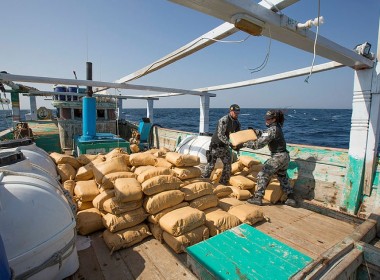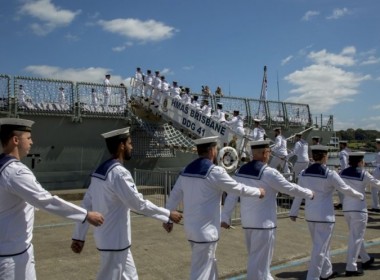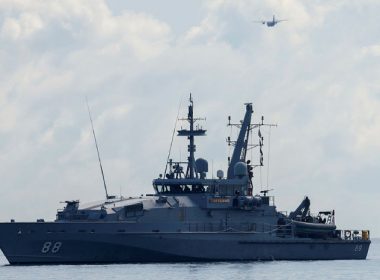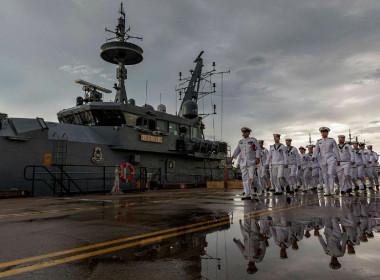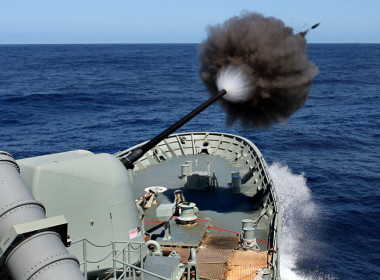OPINION | “National defence” and the Royal Australian Navy

The 2023 Defence Strategic Review (DSR) identifies itself as “the most substantial and ambitious approach to Defence reform recommended to any Australian government since the Second World War”. It maps out a pivot for the national defence strategy from the defence of Australia to the defence of Australian interests, or “national defence”.
In the lead up to the review’s release, Defence commentators commonly formed the view that it would prioritise the maritime domain at the expense of more conventional land capabilities, likely recommending significant changes to the Royal Australian Navy’s (RAN) surface fleet structure.
The navy’s surface combatants are three Hobart-class air warfare destroyers and eight Anzac-class frigates supported by 12 patrol boats that are gradually being decommissioned. The 2016 defence white paper outlined the intent to replace the Anzacs with an anti-submarine warfare frigate, the Hunter-class. The nine Hunters were to be delivered in the mid-2020s but the first is now expected in the early 2030s. That white paper also announced the intended acquisition of 12 offshore patrol vessels (OPVs) to replace the Arafura-class on “enhanced border protection and patrol missions”. The number of OPVs was later increased in the 2020 force structure plan (FSP) to 20.
The 2016 white paper and the 2020 FSP arguably articulated the largest recapitalisation of the RAN since WWII. Despite that, commentators have warned that the make-up and planned number of vessels will not be enough for the RAN to effectively protect Australia’s maritime interests, including extensive sea lines of communication and undersea cables.
The FSP detailed the importance of broadening and updating the RAN’s undersea warfare capabilities through further investment in persistent undersea surveillance and enhancement of mine warfare capabilities through the acquisition of up to eight additional vessels, potentially based on the OPV. FSP 20 also committed to the expansion of the RAN’s amphibious and sea-lift capability through the acquisition of two multi-role vessels to replace HMAS Choules, amongst other changes. Although the FSP did not fundamentally change the fleet’s intended structure beyond what was laid out in the 2016 white paper, it did seek to address the full spectrum of effects the RAN may be called upon to deliver.
“The assertion that acquiring nuclear submarines warrants a rethink of the RAN surface combatant fleet structure seems tenuous.”
There was some expectation that the DSR would recommend acquiring additional destroyers and replacing the OPVs with corvette-sized vessels. The DSR did neither, but it recommended a review of Navy’s force structure:
“Australia’s Navy must be optimised for operating in Australia’s immediate region and for the security of our sea lines of communication and maritime trade.”
The DSR articulates a need to raise the fleet’s lethality and identifies a requirement for “Tier 1 and Tier 2 surface combatants to provide increased strike, air defence, presence operations and anti-submarine warfare”. It says these roles will take an “optimal mix of Tier 1 and Tier 2 surface combatants consistent with a larger number of smaller surface vessels”. Despite identifying these investment priorities, the DSR team (at least in the unclassified version of its report) avoided recommending specific capabilities as it did for the land and air domains. Instead, it called for an independent analysis of the RAN’s surface combatants to “ensure its size, structure, and composition complement the capabilities provided by the forthcoming conventionally armed nuclear submarines”. This review will be headed by retired US Admiral William H Hilarides, chair of the government’s naval shipbuilding advisory panel.
The assertion that acquiring nuclear submarines warrants a rethink of the surface combatant fleet structure seems tenuous. I may be torpedoed by a submariner for stating this, but effectively nuclear-powered submarines deliver the same effects as a conventional submarine, just better. Reading between the lines, DSR planners may have come to the belief that acquiring nuclear submarines somehow negates the need for nine anti-submarine warfare frigates.
The maritime domain investment priorities outlined by the DSR tend to indicate that the team had a fleet force structure in mind, but they avoided articulating it, probably because of concerns raised by either the RAN or the shipbuilding industry. A likely reason is the challenge the RAN is facing maintaining its workforce. Despite the March 22 Defence workforce growth announcement, it’s likely that the RAN would be unable to crew an expanded fleet without significant structural changes to its workforce.
“[The] Navy faces the most significant workforce challenges of the three services,” the DSR added. That concern is not new. The Anzac frigates were plagued by crew shortages that saw HMAS Perth out of operation for four years from 2017 to 2020 and the RAN had difficulty sustaining crews through much of the life of the Collins submarines. Workforce issues would not have been the only concerns delaying the DSR’s recommendation on RAN force structure—with challenges including available design and shipbuilding capacity clearly front of mind, but the maths would indicate that crewing is a factor.
“It appears evident from investment priorities that the current and planned surface combatant structure will not meet the Defence Strategic Review’s ‘national defence’ projection requirements.”
It’s difficult to see how any increase in the number of surface combatants would not exacerbate the workforce shortfalls. A corvette crew is between 90 and 120, two to three times the size of an OPV crew. This might be offset by reducing the number of Hunter-class frigates, which have about 180 crew, but it’s unlikely that a smaller vessel could provide the anti-submarine warfare capability recommended in the DSR.
The Hunter design has limited strike capacity compared to other vessels of its size and the OPV is not presently designed to provide any greater defensive or offensive capabilities than are required for constabulary operations. It appears evident from the DSR’s investment priorities that the current and planned surface combatant structure will not meet the DSR’s “national defence” projection requirements.
The structure of the surface fleet remains a quandary, and a surprising one for the DSR team to delay solving given the urgency of the strategic situation it describes. It’s also notable that the relatively short section on the maritime domain limited its commentary on investment priorities to consideration of the surface combatant force and to reaffirming the justification for nuclear-powered, conventionally-armed submarines.
The limited detail on maritime priorities stands in contrast to previous white papers, or to FSP 20. This narrower focus on the maritime domain does not provide any commentary on capability considerations for the RAN regarding the integration of sea-lift, aviation, uncrewed capabilities, or undersea capabilities beyond submarines and frigates and defensive and offensive mining. It is unclear whether this was because the DSR team supported the decisions in FSP 20 and believed these capabilities to be on track to be delivered in an appropriate timeframe and therefore did they not warrant reconsideration, or because their relative importance has diminished.
Despite the conspicuous absence of recommendations on these capabilities in the DSR, it’s important that Admiral Hilarides considers them. Whilst the author believes the view that the fleet structure needs to be reviewed to complement the submarines seems tenuous, the new review will need to consider the RAN’s concept of operations, the overall effects the RAN will need to achieve in support of “national defence,” and how all its capabilities will come together to achieve this. This is likely to have a significant impact on the required structure of the RAN’s surface fleet.


